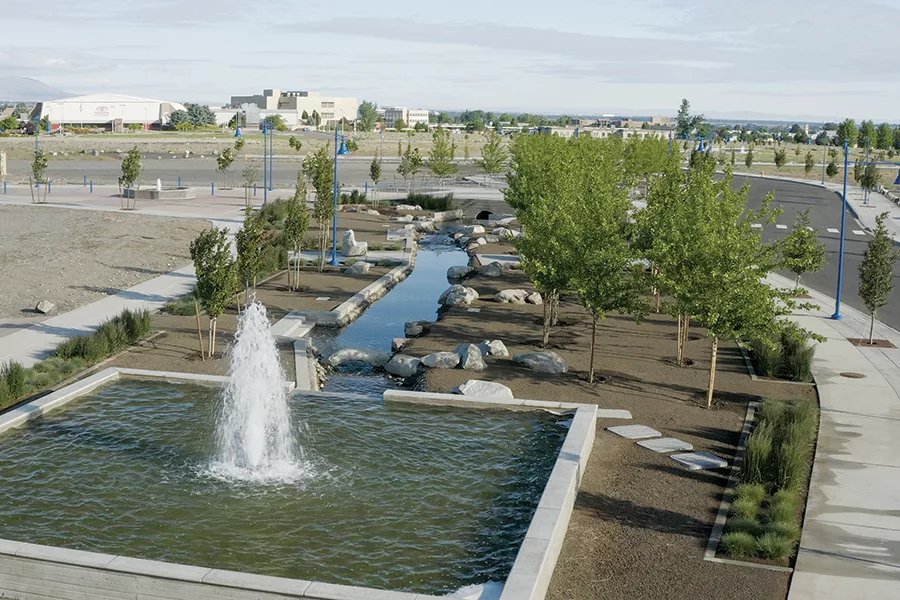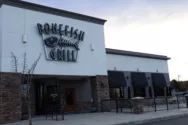
Home » Port of Kennewick: Vista Field, Columbia Gardens ready for sale
Port of Kennewick: Vista Field, Columbia Gardens ready for sale

October 15, 2021
Almost a decade after closing Vista Field, the Port of Kennewick is poised to start selling land and to welcome new construction after challenges and delays brought on by the Covid-19 pandemic.
“Everything has to be talked about against the backdrop of where we’re still at in 2021,” said Tim Arntzen, the port’s chief executive officer. “We’re in a different world right now. Prior to Covid, we’d been foot on the gas, ready to roll things out.”
The port is ready to offer up its desirable land – right in the heart of Kennewick and never previously available to private developers – now that the city of Kennewick has signed off on about $4 million in infrastructure work at the former municipal airport, described as “first cabin, no cutting corners.”
This includes road work, sidewalks, utilities and landscaping to prep the site for project proposals on shovel-ready land.
“We’re ready to pop, in a real positive way,” Arntzen said.
From here, the port will finalize design standards and set pricing before soliciting requests from developers interested in building there.
A key feature of the infrastructure includes a chlorinated stream running from West Deschutes Avenue north toward West Rio Grande Avenue. The water feature in the middle of the former airport includes trees, waterfalls, rocks, bridges, fountains, benches and walking paths.
“That stream is going to rival the lighthouse for an iconic feature in our community,” Arntzen said, referring to the port’s lighthouse on Clover Island. “There’s a lot of pride that we built something that’s drawing wildlife.”
Unexpected pandemic-related chlorine shortages occasionally have affected the clarity of the stream, but Arntzen is optimistic the shortage will pass.
‘Most coveted area’
Arntzen predicts “for sale” signs will be in the ground after the first of the year and the first land sale publicized by March 2022.
“We’ve got a diamond in the rough, and it’s a big one. We are going to figure out a few paperwork things right now, but this is our diamond mine and we’ve got to find our diamond buyers,” he said.
Buyers will be building on land Arntzen believes to be the “most coveted area in the Tri-Cities.”
“I don’t care how you draw the map, if you put crosshairs at the center, it’s Vista Field, and we own it,” he said.
Projects will need to align with a master plan for walkable streets offering a mix of commercial, retail and residential development across 103 acres.
“We’re going to be forthright and aggressive in selling this property to a builder for the right price that will do great things,” Arntzen said. “We’re a community that likes government to get ... out of the way. We like the private sector to do things rather than government building empires.”
Getting the land on the tax rolls will include partnering with local builders who can execute the vision of 1,100 residential units in a “pedestrian-focused regional town center” that also will include civic amenities, entertainment and recreation opportunities throughout small-scale streets designed to encourage limited use of vehicles.
Columbia Gardens
The port’s Columbia Gardens Urban Wine & Artisan Village has grown to include four wineries, plus a parking lot that doubles as its Food Truck Plaza.
The port has added string lights, seating and canopies for shade to encourage customers to patronize the regular eateries like Culture Shock Bistro, Swampy’s BBQ Sauce & Eatery, Nonfiction and Bobablastic Tri-Cities.
New fencing with a standing-height counter area was added and permanent restrooms are in the works.

“The greatest thing would be if we could get through Covid. You need the people to have great things; we need them to be circulating in our wine village,” Arntzen said. “We have great plans for the waterfront.”
Highlighting the waterfront
The waterfront has taken on a whole new dynamic with the addition of the wine village and the ongoing rehab of Clover Island.
The projects were part of the port’s last master plan, first adopted about 15 years ago.
After completing 90% of the items on the list, the port wrapped its new master plan covering Clover Island and the near shore and found the pandemic benefited the planning process.
“We got way more participation with people doing it strictly remotely. We got a ton of public participation – possibly three times as much as the last one,” Arntzen said.
The Kennewick Historic Waterfront District Master Plan will work to guide the priority projects for investments around Clover Island and Columbia Gardens, as well as The Willows, a mixed-use site covering nearly seven acres by the waterfront, and Cable Greens, the property at the base of the cable bridge, just east of the wine village, and also intended for mixed use.
Development at The Willows and Cable Greens has been part of a long-term vision to acquire properties and rehabilitate them.
“We have more property than we did in 2004,” said Arntzen, who said the properties once had the perception of being “grungy or downtrodden,” but that’s no longer the case.
He believes people want to live on waterfront land, and the port has worked to make the area even more appealing through updates to the nearby Duffy’s Pond and walking trails.
The port also developed an owners’ association and is working to set pricing for selling parcels.
Road work throughout the spring and summer on nearby Washington Street will help connect the waterfront with Kennewick’s commercial core, adding landscaping planters, lighting and wider sidewalks between Columbia Drive and Kennewick Avenue.
It will make the waterfront and downtown core more walkable, a benefit the port was happy to chip in $500,000 toward the project cost.
“East Kennewick has been the forgotten part of town – and it’s where the community started,” Arntzen said. “After the downtown core decayed over time, millions have been pumped back in, and you’ve got to do that – so you can give people a reason to stay and come to this side of town.”
Arntzen said improvements at the waterfront have progressed with market demand.
“There were things we couldn’t implement before – there probably wasn’t time for it. Now it’s getting closer to time, and people want to invest with their own dollars,” he said.
A project planned for late 2021 will restore shorelines on Clover Island and extend recreation paths along the river.
Board turnover
The 12-person staff for the Port of Kennewick will welcome a familiar new face to its board of commissioners with the departure of Don Barnes, current board president and commissioner for nearly a decade.
He’s set to be replaced by Ken Hohenberg, Kennewick’s current police chief and assistant city manager. As the sole candidate for the open District 1 position in the November election, Hohenberg will take office in January 2022.
“It’s a perfect fit for me,” Hohenberg said, reflecting on his desire to continue serving the community following his planned retirement in February 2022 as police chief.
“When I retire, it’s good to separate myself from city government and cut the strings,” he said.
Arntzen looks forward to Hohenberg joining the commission.
“He is one of the most prominent statespersons in our community, and I’m really excited to give him a chance to get his hands on the controls,” he said.
Hohenberg comes to the commission following a couple years of infighting that resulted in a formal complaint lodged against Barnes and Tom Moak by a fellow commissioner, Skip Novakovich. It ended up costing taxpayers nearly half-a-million dollars in investigative costs before being resolved.
“When you go from an active organization, a new speed record broken every day, and then you have the procedural and political stuff, it takes a bite out of you,” Arntzen said.
Hohenberg said Barnes has been “thoughtful” with his time and helped prepare the incoming commissioner, as Hohenberg hopes to move beyond the past distractions.
“The port has done a lot of great projects over the years and made courageous decisions. Barnes was part of the decision to close the airport (Vista Field), but I believe it’s created a much better benefit to all Tri-Citians. I want to capitalize on that and see some of these projects come out of the ground,” Hohenberg said.
The port has recently invested in projects within its boundaries, including partnering with the city of Richland to spend $800,000 in improvements to Columbia Park Trail, adding sidewalks, a bike path and lighting.
It also sold land in the city of West Richland that is the site of the city’s new police station, now under construction. It will be completed in November.
Another land sale in West Richland allowed Benton Fire District 4 to build its Keene Road station, which opened this summer, to support the continued growth at the west end of the Tri-Cities.
“If your objective is to build things for the community, it doesn’t matter who does it,” Arntzen said.
Construction + Real Estate
KEYWORDS october 2021





